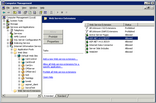System requirements
Please review the current system requirements for setup considerations and suggestions. Review each section in advance before making expensive hardware and network decisions that may not be in line with LexisNexis CaseMap or TextMap recommendations.
Please keep informed of CaseMap Server, CaseMap Admin Console, and CaseMap SQL Import Utility release updates and how they impact your system by contacting your CaseMap Sales or Support Representative.
|
When setting up users for local cases, ensure that all users have full network access to each case directory they need to access. When setting up users for SQL cases in the CaseMap Admin Console, ensure that users are assigned appropriate roles and assigned to the cases they need access. |
CaseMap Server is a Windows® .NET Windows Communications Foundation (WCF) Web service that authenticates CaseMap users and is used to store or retrieve data from the admin database. CaseMap Server must be installed on a local hard drive. You must be logged on with admin rights to install CaseMap Server.
Microsoft Windows 2008 Server® Microsoft Windows 2012 Server® Microsoft Windows 2016 Server®
Microsoft Windows Microsoft IIS 7.0® Microsoft Windows Microsoft IIS 7.5® Microsoft Windows Microsoft IIS 8.0® Microsoft Windows Microsoft IIS 10.0®
Installation Location: CaseMap Server must be installed on a local hard drive. You must be logged on with Admin rights to install CaseMap Server.
Special Notes:
Admin Console Endpoint Default URL: http://[Web Server Name]/CMServer/CMServerAdmin.svc
Client Application Endpoint Default URL: http://[Web Server Name]/CMServer/CMServerClient.svc
\
|
The CaseMap Admin Console is the Windows desktop application providing access to the CaseMap Server Web Service. Install the CaseMap Admin Console to the Microsoft Windows desktop of any user who will administer TextMap SQL cases and other users. The CaseMap Admin Console must be installed and run on a local hard drive. The CaseMap Admin Console can not be run from a network server. CaseMap Admin Console data is stored on an Admin Database residing in a Microsoft® SQL Server® database. You must be logged on with Admin rights to install the CaseMap Admin Console.
Microsoft Windows 2008 Server® Microsoft Windows 2012 Server® Microsoft Windows 2016 Server® Microsoft Windows Vista® Microsoft Windows 7® Microsoft Windows 8® Microsoft Windows 10®
|
Review the following for additional information regarding recommendations.
|



